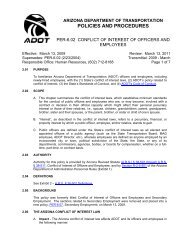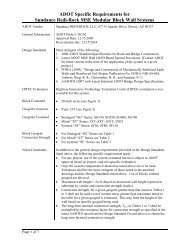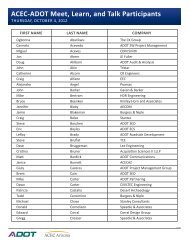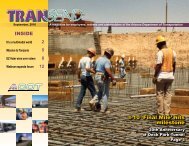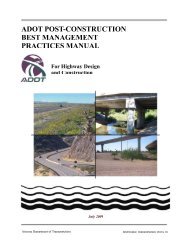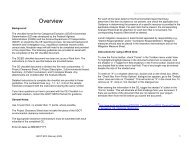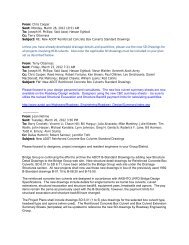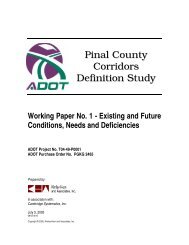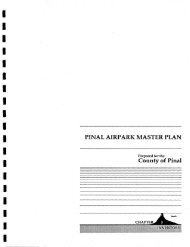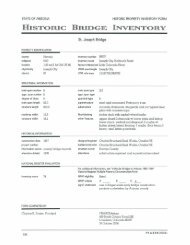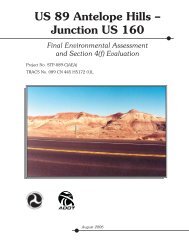I-10 Twin Peaks Traffic Interchange, Environmental Assessment
I-10 Twin Peaks Traffic Interchange, Environmental Assessment
I-10 Twin Peaks Traffic Interchange, Environmental Assessment
Create successful ePaper yourself
Turn your PDF publications into a flip-book with our unique Google optimized e-Paper software.
Affected Environment and <strong>Environmental</strong> Impacts October 2005<br />
Existing Conditions<br />
Foreground Views<br />
Foreground views in the study area include the low flow channel of the Santa Cruz<br />
River Floodplain, containing riparian vegetation and perennial effluent dominated<br />
water. Other foreground views include I-<strong>10</strong>, the UPRR, and TEP transmission<br />
lines.<br />
Background Views<br />
Middle ground views from both <strong>Twin</strong> <strong>Peaks</strong> Road and along I-<strong>10</strong> include the Santa<br />
Cruz River. The Santa Cruz River is an important water feature that runs in a<br />
northwesterly direction through the study area. The width of the Santa Cruz River<br />
is constricted in places by bank protection and flood control measures. Suburban<br />
development characterizes the area west and southwest of the study area and<br />
industrial land uses (portland cement plant) are visible to the southeast.<br />
The most memorable views within the study area are the background views: the<br />
Tucson Mountains to the west and southwest; the Rincon Mountains to the<br />
southeast; the Catalina Mountains to the east; and Tortolita Mountains to the<br />
northeast.<br />
Visual Quality Objectives<br />
Important natural visual resources within the study area (landform, water,<br />
vegetation, and natural colors) and cultural visual resources (ranching and grazing<br />
lands, residential, commercial, and industrial developments) were assessed and<br />
evaluated following the guidelines of the FHWA Visual Impact <strong>Assessment</strong> for<br />
Highway Projects (1981), the Bureau of Land Management (BLM) Visual<br />
Resource Management Manual (1981), and Pima County Department of<br />
Transportation and Flood Control District (PCDOT&FCD). The objective of the<br />
visual impact assessment is to better provide roadway users and community<br />
project viewers with a transportation system that is pleasing to the senses,<br />
assimilates the visual qualities of the community’s visual resources into its design,<br />
and makes the project compatible with the community at large.<br />
Impacts<br />
Visual impacts of the proposed improvements were determined by assessing the<br />
change in visual resources caused by the preferred alternative and then by<br />
predicting viewer response to that change of visual resources. To assess the visual<br />
resource change, the visual compatibility and/or visual contrast of the proposed<br />
alternative with the visual character of the existing landscape was examined. To<br />
predict viewer response, viewer exposure and viewer sensitivity was considered.<br />
Viewer exposure considers the physical limits of the views and the number of<br />
affected viewers. Viewer sensitivity considers viewer expectations based on the<br />
existing environment and the extent to which visual elements may be important to<br />
the viewer. The visual impacts of the preferred alternative were analyzed from six<br />
Interstate <strong>10</strong> <strong>Traffic</strong> <strong>Interchange</strong> at<br />
<strong>Twin</strong> <strong>Peaks</strong>/Linda Vista<br />
4-42<br />
Project No.: NH-0<strong>10</strong>-D (AIW)<br />
TRACS No.: <strong>10</strong> PM 236 H5838 01D



